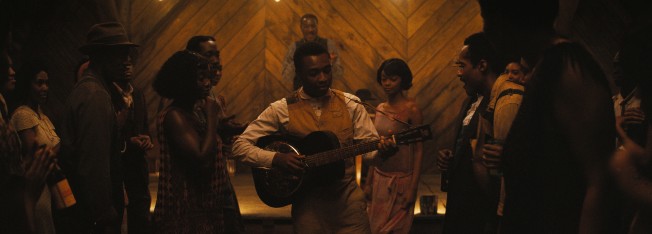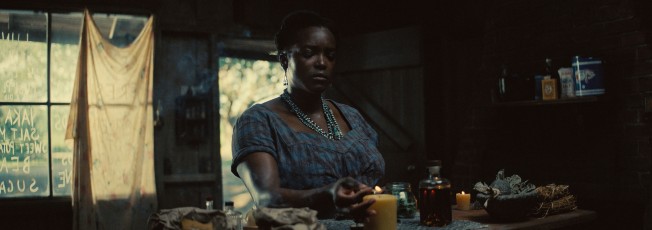Today we get aboard the awards season on-ramp which will ultimately lead to The Road To Oscar, SHOOT’s 16-part series of feature stories covering Academy Award contenders. The Road To Oscar gets underway on November 14. In anticipation of that series, this preview installment connects with cinematographer Autumn Durald Arkapaw, ASC who made history with her lensing of writer-director Ryan Coogler’s Sinners (Warner Bros. Pictures). The film, Coogler, Durald Arkapaw and a number of their colleagues entered the Oscar conversation back in April when Sinners hit theaters, becoming a critical and commercial success.
In some respects, Sinners is several movies rolled into one, blending genres such as horror, musical, drama, big-screen spectacle and period piece–the latter slice of history chronicling the racially segregated South during the Jim Crow era. A journey through vampire folklore at the same time uncovers the real-world horrors of racism and oppression.
This multi-dimensional film inherently posed assorted technical and creative challenges to Durald Arkapaw. Making those challenges easier to take on were her friendship, affinity for and deep collaborative relationship with Coogler for whom she previously shot Black Panther: Wakanda Forever. Durald Arkapaw and Coogler struck up a creative rapport on that blockbuster hit, developing a shorthand which served them well on Sinners, her second film with Coogler.
Durald Arkapaw made the alluded-to cinematic history for her work on Sinners, becoming the first woman to shoot a feature on large format IMAX film. It’s a distinction she’s embraced and is proud of, hoping that the next generation of aspiring female cinematographers–including those of color–will find inspiration in that milestone.
But, as always, Durald Arkapaw’s technical pursuits–and achievements–are driven by her desire to do full justice to the narrative. Towards that end, she noted that most invaluable for her has been Coogler’s vision for the story he wants to tell, generally shared in their initial meeting of minds on a project.
For Durald Arkapaw, a guiding light on Sinners was the humanity Coogler wanted to infuse the story with–a key visual reference being the still photography of Eudora Welty in 1930s’ Mississippi. Welty made her first mark as a photographer before going on to become an accomplished author. Coogler cited her photography as a visual inspiration for what he wanted to capture in Sinners, reflecting the Black experience in that era–and the humanity of a populace that was given short shrift in the public eye. Robert MacNeil, the late journalist known for his tenure on PBS, including co-anchoring The MacNeil/Lehrer Report and The MacNeil/Lehrer NewsHour with Jim Lehrer, was a friend of Welty. MacNeil observed that Welty’s images from the ‘30s chronicled a richly beautiful and caring Black America culture that was otherwise invisible in mainstream society. It was the humanity and spontaneity of those pictures that Coogler shared with Durald Arkapaw as visual guidance and inspiration for Sinners. Grounded in relatable humanity, the work of Coogler and Durald Arkapaw gives Sinners a resonance that has meant the world to Durald Arkapaw–and helped her to build that world which Coogler envisioned.
Sinners introduces us to street-smart twins Smoke and Stack (portrayed by Michael B. Jordan) who return home to the Mississippi Delta–after making major coin working for the mob in Chicago. Looking to go into business for themselves, Smoke and Stack convert a sawmill (brought from a racist landowner) into a juke joint where the locals can unwind with food, drink and inspired blues music. The twins recruit their young cousin Sammie (Miles Caton), a self-taught, talented blues guitarist, and Delta Slim (Delroy Lindo), a veteran pianist, as marquee performers. Smoke’s estranged wife Annie (Wunmi Mosaku), a Hoodoo practitioner and spiritualist, is brought on as the cook, while Chinese shopkeepers Grace (Li Jun Li) and Bo (Yao), a married couple, are key suppliers (including handling some sign making) for the business. We see these and other elements fall into place–such as Stack reconnecting with his former girlfriend Mary (Hailee Steinfeld)–during the course of a fateful day, extending into a brutal, terror-filled night when a clan of vampires–led by the ruthless yet strangely charming Remmick (Jack O’Connell)–infiltrate the community, turning the juke joint into a chamber of horrors.
Coogler initially planned to shoot Sinners on 16mm film but over time his format of choice grew larger, jumping to 35mm at one point with the ultimate decision being to mix footage from two different 65mm film formats–from IMAX 15-perf and Ultra Panavision 70 cameras. This combination allowed the film to switch between the taller 1.43:1 IMAX aspect ratio and the wider 2.76:1 Ultra Panavision aspect ratio depending on the requirements of a given scene. The specific cameras used included the IMAX MSM 9802 and MKIV Reflex cameras, and the Panavision System 65 Studio High Speed cameras.
Generally speaking, the noise of the IMAX camera precludes it from being deployed on dialogue-heavy scenes. But Durald Arkapaw noted that Coogler isn’t afraid to buck the norm when he sees benefits that make sense even if counterintuitive on the surface. For example, there’s a scene where Sammie returns to church after a frightful final fight with vampire Remmick. Sammie comes face to face with his pastor father in a dramatic exchange that’s emotionally intense and dialogue-intensive. Coogler strongly felt that this pivotal encounter needed to be in IMAX for optimum impact. To address the loudness of the IMAX cameras, Coogler consulted the actors, got their approval and went with ADR (Automated Dialogue Replacement) for this sequence.
Durald Arkapaw noted that the complexities and highly ambitious nature of Coogler’s work can be daunting–but such challenges are less so because of the writer-director’s brilliance in assembling an ensemble of artists and problem solvers who care for one another. “I feel fortunate to make a film like this on that scale with people I consider to be family and friends,” said Durald Arkapaw, noting that Coogler creates this collaborative culture with people who “enjoy making films with each other. People respond to that. Audiences feel that,” she affirmed.
Sinners is in the official lineup–and nominated for a Golden Frog–at Poland’s Camerimage Film Festival later this month. Sinners adds to a body of work for Durald Arkapaw which ranges from indie films like Palo Alto to documentary fare such as Beastie Boys Story, and major studio projects like Loki–which earned her a primetime Emmy nomination–and Black Panther: Wakanda Forever. Durald Arkapaw also enjoys collaborative bonds with filmmakers other than Coogler. For example she’s notably shot for director Gia Coppola spanning such features as Palo Alto, Mainstream and most recently The Last Showgirl starring Pamela Anderson in a tour de force performance. The Last Showgirl made its world premiere at last year’s Toronto International Film Festival. Durald Arkapaw recalled receiving the script for Sinners from Coogler the night prior to when she started shooting The Last Showgirl.
SHOOT’S 16-part The Road To Oscar Series begins on November 14. The series will appear weekly through the Academy Awards gala ceremony. Nominations for the 98th Oscars will be announced on Thursday, January 22, 2026. The 98th Oscars will be held on Sunday, March 15, 2026, at the Dolby Theatre at Ovation Hollywood in Hollywood, Calif., televised live on ABC and streamed on Hulu.





